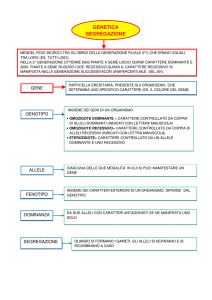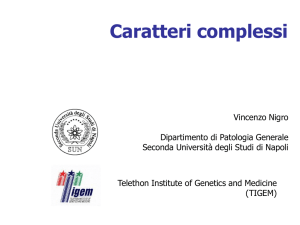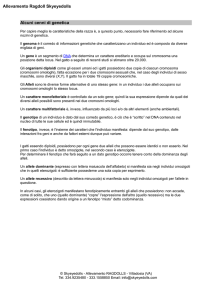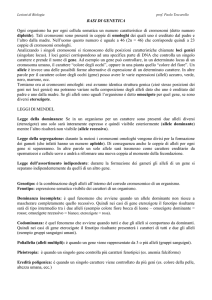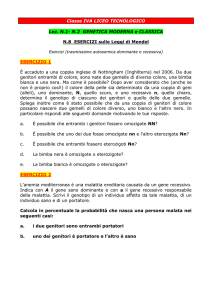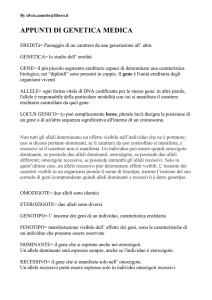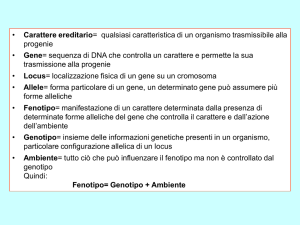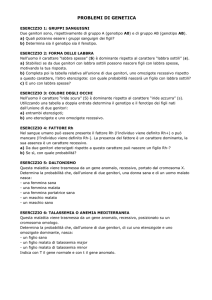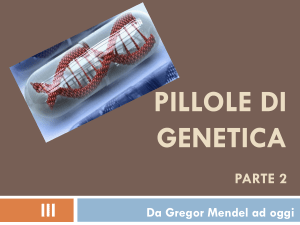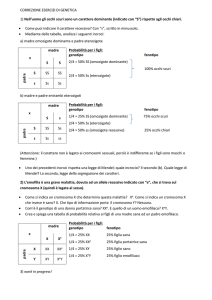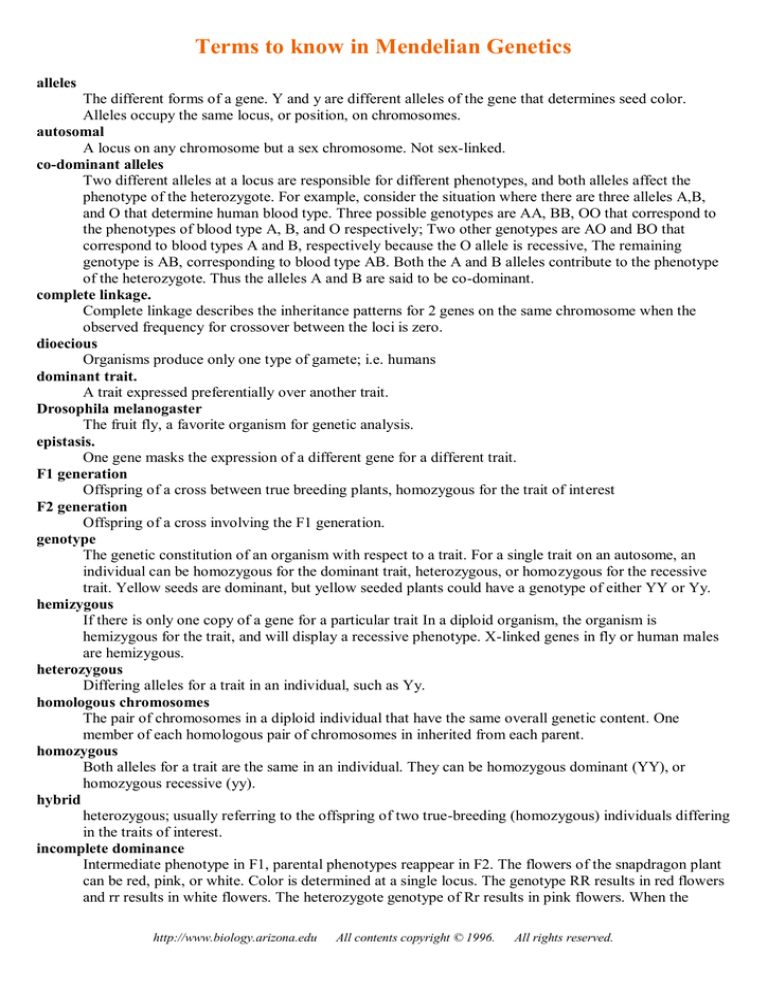
Terms to know in Mendelian Genetics
alleles
The different forms of a gene. Y and y are different alleles of the gene that determines seed color.
Alleles occupy the same locus, or position, on chromosomes.
autosomal
A locus on any chromosome but a sex chromosome. Not sex-linked.
co-dominant alleles
Two different alleles at a locus are responsible for different phenotypes, and both alleles affect the
phenotype of the heterozygote. For example, consider the situation where there are three alleles A,B,
and O that determine human blood type. Three possible genotypes are AA, BB, OO that correspond to
the phenotypes of blood type A, B, and O respectively; Two other genotypes are AO and BO that
correspond to blood types A and B, respectively because the O allele is recessive, The remaining
genotype is AB, corresponding to blood type AB. Both the A and B alleles contribute to the phenotype
of the heterozygote. Thus the alleles A and B are said to be co-dominant.
complete linkage.
Complete linkage describes the inheritance patterns for 2 genes on the same chromosome when the
observed frequency for crossover between the loci is zero.
dioecious
Organisms produce only one type of gamete; i.e. humans
dominant trait.
A trait expressed preferentially over another trait.
Drosophila melanogaster
The fruit fly, a favorite organism for genetic analysis.
epistasis.
One gene masks the expression of a different gene for a different trait.
F1 generation
Offspring of a cross between true breeding plants, homozygous for the trait of interest
F2 generation
Offspring of a cross involving the F1 generation.
genotype
The genetic constitution of an organism with respect to a trait. For a single trait on an autosome, an
individual can be homozygous for the dominant trait, heterozygous, or homozygous for the recessive
trait. Yellow seeds are dominant, but yellow seeded plants could have a genotype of either YY or Yy.
hemizygous
If there is only one copy of a gene for a particular trait In a diploid organism, the organism is
hemizygous for the trait, and will display a recessive phenotype. X-linked genes in fly or human males
are hemizygous.
heterozygous
Differing alleles for a trait in an individual, such as Yy.
homologous chromosomes
The pair of chromosomes in a diploid individual that have the same overall genetic content. One
member of each homologous pair of chromosomes in inherited from each parent.
homozygous
Both alleles for a trait are the same in an individual. They can be homozygous dominant (YY), or
homozygous recessive (yy).
hybrid
heterozygous; usually referring to the offspring of two true-breeding (homozygous) individuals differing
in the traits of interest.
incomplete dominance
Intermediate phenotype in F1, parental phenotypes reappear in F2. The flowers of the snapdragon plant
can be red, pink, or white. Color is determined at a single locus. The genotype RR results in red flowers
and rr results in white flowers. The heterozygote genotype of Rr results in pink flowers. When the
http://www.biology.arizona.edu
All contents copyright © 1996.
All rights reserved.
heterozygote has a different, intermediate phenotype compared to the homozygous dominant or
homozygous recessive individuals, this is said to be incomplete dominance.
lethal alleles.
Mutated genes that are capable of causing death.
linkage.
genes that are inherited together on the same chromosome. Three inheritance patterns are possible: nonlinkage, Partial linkage, and complete linkage.
mendel's law of independent assortment of alleles.
Alleles of different genes are assorted independently of one another during the formation of gametes.
mendel's law of segregation
Alleles segregate from one another during the formation of gametes.
monoecious
Organisms produce both male and female gametes; i.e. garden pea.
monohybrid cross.
Cross involving parents differing in only one trait.
mutation
Change in the DNA sequence of a gene to some new, heritable form. Generally, but now always a
recessive allele.
non-linkage.
Non-linkage describes the inheritance patterns for 2 genes on the same chromosome, when the expected
frequency for crossover between the loci is at least one. The observed inheritance patters for non-linked
genes on the same chromosome is the same as for 2 genes on different chromosomes.
partial linkage.
Partial linkage describes one of the inheritance patterns for 2 genes on the same chromosome, when the
expected frequency for crossover between the loci is greater than zero but less than one. From partial
linkage analysis we can learn about the order and spacing of genes on the same chromosome.
phenotype
The physical appearance of an organism with respect to a trait, i.e. yellow (Y) or green (y) seeds in
garden peas. The dominant trait is normally represented with a capital letter, and the recessive trait with
the same lower case letter.
pleiotropic.
A single gene determines more than one phenotype for an organism.
recessive trait.
The opposite of dominant. A trait that is preferentially masked.
reciprocal cross
Using male and female gametes for two different traits, alternating the source of gametes.
sex chromosomes
Sex determination is based on sex chromosomes
sex-linked.
A gene coded on a sex chromosome, such as the X-chromosome linked genes of flies and man.
test cross
Generally a cross involving a homozygous recessive individual. When a single trait is being studies, a
test cross is a cross between an individual with the dominant phenotype but of unknown genotype
(homozygous or heterozygous) with a homozygous recessive individual. If the unknown is
heterozygous, then approximately 50% of the offspring should display the recessive phenotype.
true-breeding
Homozygous for the true-breeding trait.
wild-type allele
The non-mutant form of a gene, encoding the normal genetic function. Generally, but not always a
dominant allele.
Per un GLOSSARIO CON PRONUNCIA DEI TERMINI http://anthro.palomar.edu/mendel/glossary.htm
http://www.biology.arizona.edu
All contents copyright © 1996.
All rights reserved.
Termini da conoscere nella Genetica Mendeliana
alleli
Le differenti forme di un gene. Y e y sono la coppia di alleli che determinano il colore del seme. Gli
alleli occupano loci, o posizioni, corrispondenti sui cromosomi omologhi.
autosomico
Un locus su qualsiasi cromosoma eccetto i cromosomi sessuali. Non sex-linked.
alleli co-dominanti
Due alleli diversi in un locus sono responsabili per diversi fenotipi, ed entrambi influiscono sul fenotipo
dell' eterozigote. Per esempio, si consideri la situazione dove vi sono tre alleli (allelia multipla) A,B, e O
che determinano il gruppo sanguigno umano. Vi sono tre possibili genotipi AA, BB, OO che
corrispondono ai fenotipi del sangue tipo A, B, e O rispettivamente; Due altri genotipi sono AO e BO
che corrispondono al sangue tipo A e B rispettivamente, perché l' allele O é recessivo, L'ultimo genotipo
é AB, che corrisponde al sangue di tipo AB. Entrambi gli alleli A e B contribuiscono al fenotipo dell'
eterozigote. Perciò gli alleli A e B vengono chiamati co-dominanti.
linkage completo (associazione).
Il linkage completo descrive il comportamento ereditario di 2 geni sullo stesso cromosoma quando si
osserva una frequenza di crossing-over fra i loci uguale a zero.
dioico
Organismo che produce solo un tipo di gamete; es. l' uomo.
Carattere dominante.
Un carattere espresso in modo preferenziale rispetto a l' altro.
Drosophila melanogaster
Il moscerino della frutta, (organismo preferito nelle analisi genetiche).
epistasi.
Un gene maschera l' espressione di un altro gene per un diverso carattere.
Generazione F1
Discendenza di un incrocio fra razze pure, o omozigote, per il carattere in esame.
Generazione F2
Discendenza di un incrocio che riguarda individui della F1.
genotipo
L' assetto genetico di un organismo riferito al carattere. Per un singolo carattere autosomico, un
individuo può essere omozigote per un carattere dominante, eterozigote, o omozigote per un carattere
recessivo. I semi gialli sono dominanti, ma le piante a semi gialli possono avere genotipo sia YY che
Yy.
emizigote
Se vi è una sola copia (allele) di un gene per un particolare carattere, in un organismo diploide, l'
individuo è emizigote per quel carattere e mostrerà il fenotipo recessivo. I geni X-linked nel maschio
della drosofila e della specie umana sono in emizigosi.
eterozigote
Differenti alleli per un carattere in un individuo, come Yy.
cromosomi omologhi
Coppia di cromosomi in un individuo diploide che contengono la stessa sequenza di geni. Ciascun
cromosoma omologo della coppia viene ereditato da uno dei genitori.
omozigote
Entrambi gli alleli per un carattere sono uguali nello stesso individuo. Può essere omozigote dominante
(YY), o omozigote recessivo (yy).
ibrido
eterozigote; normalmente si riferisce alla discendenza dell 'incrocio fra due individui appartenenti a
razze pure (omozigoti) che differiscono per i caratteri in esame.
dominanza incompleta
Fenotipi intermedi in F1; i fenotipi parentali ricompaiono in F2. I fiori di della Bella di notte possono
essere rossi, rosa o bianchi. Il colore è determinato da un singolo locus. Il genotipo RR presenta fiori
rossi mentre rr presenta fiori bianchi. L' eterozigote Rr presenta fiori rosa. Quando un eterozigote
http://www.biology.arizona.edu
All contents copyright © 1996.
All rights reserved.
presenta un fenotipo intermedio rispetto all 'individuo omozigote dominante o omozigote recessivo, si
parla di dominanza incompleta.
alleli letali.
Geni mutati che sono capaci di causare la morte (normalmente quando in omozigosi).
linkage.
geni che vengono ereditati insieme sullo stesso cromosoma. Sono possibili tre modalità di eredità: nonlinkage, Linkage parziale, e linkage completo.
Legge di Mendel dell' assortimento indipendente degli alleli.
Gli Alleli di differenti geni assortiscono indipendentemente gli uni dagli altri durante la formazione dei
gameti.
Legge di Mendel della segregazione
Gli Alleli segregano gli uni dagli altri durante la formazione dei gameti.
monoico
Organismo che produce sia gameti maschili che femminili.
incrocio monoibrido.
Incrocio che coinvolge genitori che differiscono per un solo carattere.
mutazione
Variazione della sequenza del DNA di un gene in una nuova forma ereditabile. Generalmente, ma non
sempre risulta in un allele recessivo.
non-linkage.
Non-linkage descrive il modello di eredità per 2 geni sullo stesso cromosoma, quando la frequenza
attesa per il crossing over fra i loci è almeno 1. Il modello di eredità osservato per i geni non-linked
sullo stesso cromosoma è lo stesso che per due geni su 2 differenti cromosomi (indipendenza).
linkage parziale.
Il linkage parziale è un modello di eredità per 2 geni sullo stesso cromosoma, quando la frequenza attesa
per il crossing over fra i loci è maggiore di zero ma inferiore a uno. Per mezzo dell'analisi del linkage
parziale si possono avere informazione sull'ordine lineare e la distanza dei geni sullo stesso cromosoma.
fenotipo
E' la manifestazione fisica di un organismo rispetto a un carattere, es: semi gialli (Y) o verdi (y) nelle
piante di pisello. Il carattere dominante si rappresenta normalmente con la lettera maiuscole, mentre il
carattere recessivo con la stessa lettera minuscola.
pleiotropia.
Quando un solo gene influisce su più di un fenotipo in un organismo.
carattere recessivo.
Il contrario di dominante. Un carattere che è normalmente mascherato.
Incrocio reciproco
Quando si usano gameti maschili e femminili per due diversi caratteri, alternando la fonte dei gameti.
cromosomi sessuali
Cromosomi che determinano il sesso
eredità sex-linked.
Geni presenti sui cromosomi sessuali, come i geni presenti sul cromosoma (X- linked) nei moscerini e
nell'uomo.
test cross o back cross
Generalmente un incrocio che utilizza un individuo omozigote recessivo. Quando si studia un singolo
carattere,un test cross è un incrocio fra un individuo con fenotipo dominante ma con genotipo ignoto
(omozigote o eterozigote) con un individuo omozigote recessivo. Se l'individuo in esame è eterozigote,
approssimativamente il 50% della discendenza mostrerà il fenotipo recessivo.
razza pura
Omozigote per il carattere in esame.
allele selvatico
Forma del gene non mutato che codifica per una funzione genetica normale. Generalmente, ma non
sempre è un allele dominante.
Per un GLOSSARIO CON PRONUNCIA DEI TERMINI http://anthro.palomar.edu/mendel/glossary.htm
http://www.biology.arizona.edu
All contents copyright © 1996.
All rights reserved.

